Tap into Poetry is a non-profit magazine established in 2022. Through the sharing of poetry, we strive to be an exposition both for aspiring poets broadening their portfolios, and for literature enthusiasts looking to stumble across contemporary masterpieces. We aim to help authors in the advertising of their newly published work, alongside up-and-coming releases – for more information on advertising please contact us via our email tapintopoetry@gmail.com. Each featured poet retains full credit for their work, Tap into Poetry does not claim the rights to any of the poems featured in our magazine. Please refer to the end of the magazine for more information on sourcing. If you are interested in being featured in an upcoming edition, please see our submissions page for more information.
Thank you for tuning into the third edition of our magazine Tap into Poetry. To begin with I’d like to show you some poetry zines (short for magazines) I purchased from a number of Etsy stores. I was introduced to poetry zines through the popular TikTok hashtag #PoetryTok, as zines are a way for small poets to get themselves published, alongside being a form of content that allows audiences to support their favourite literature-based content creators/influencers. I won’t show the entire zines, as to encourage our audience to support the small businesses of fellow poets – but I do heavily encourage you to investigate and support them, these zines cost me between £1-2 each, but they deserve so much more. Both Etsy sellers were super helpful, and quick to respond, I hope to order more poetry zines soon! Tap into Poetry supports poets on their journey to publishing ❤
TigerLilyZines: https://www.etsy.com/uk/shop/TigerLilyZines?ref=yr_purchases
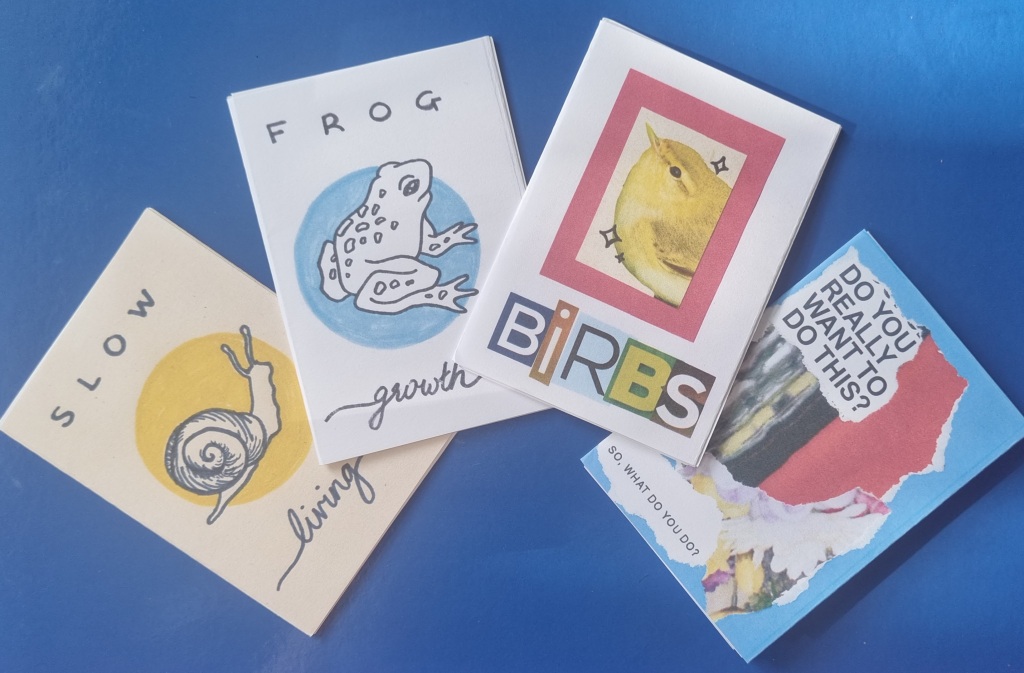
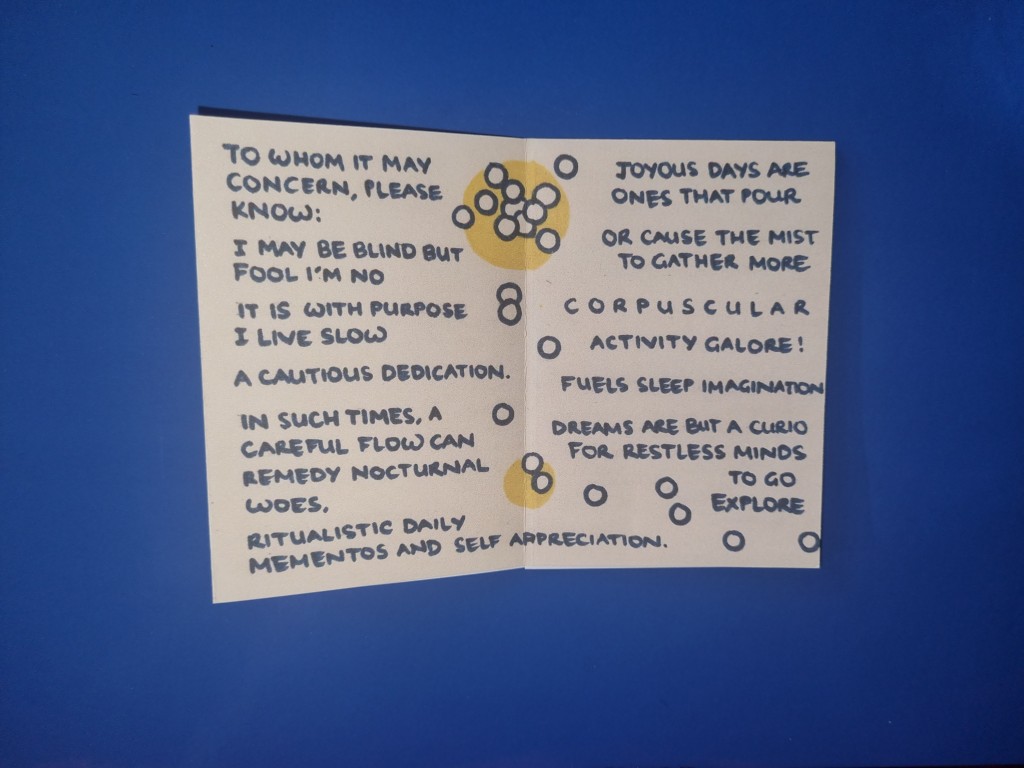
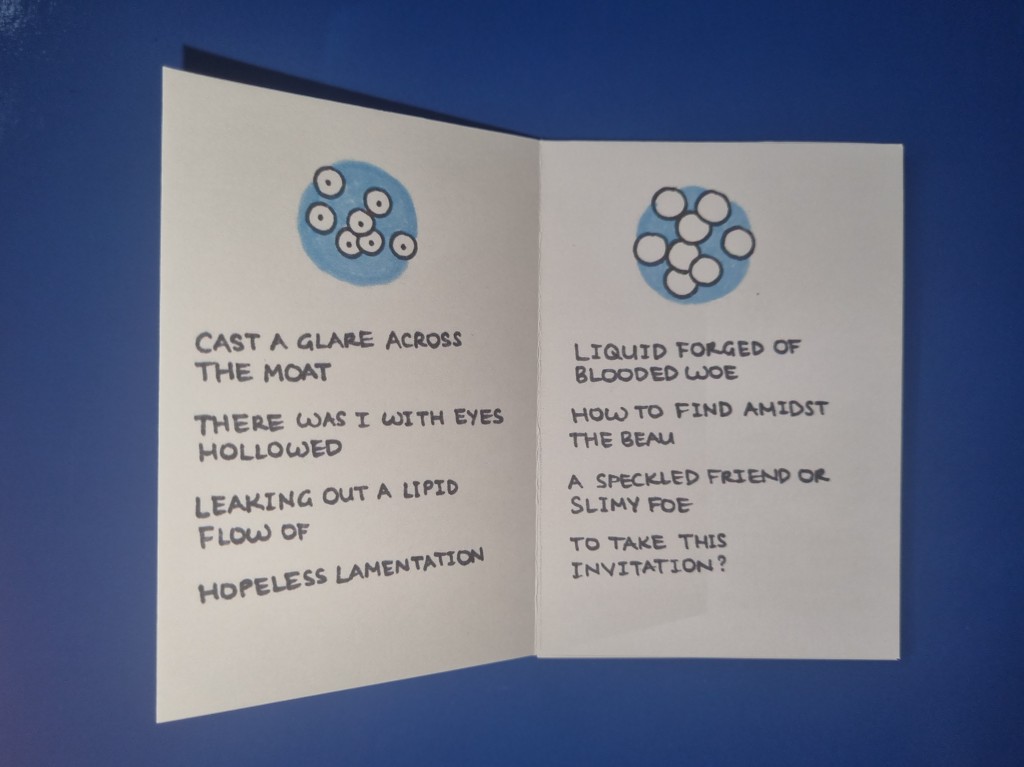
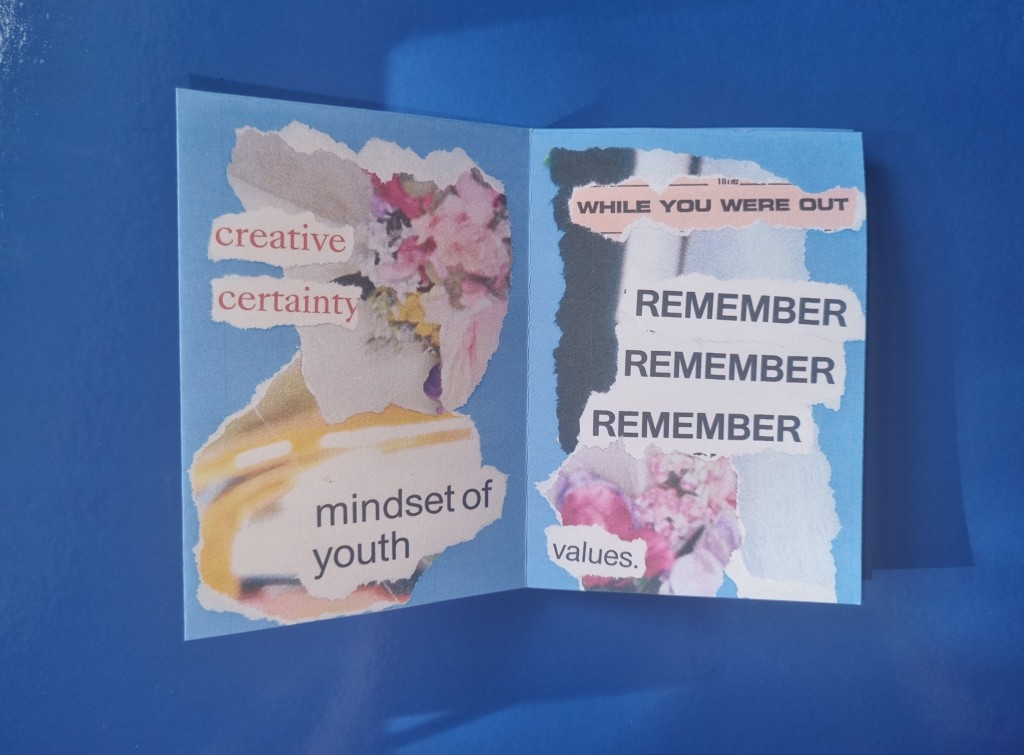
CraftMeAStoryUK: https://www.etsy.com/uk/shop/CraftMeAStoryUK?ref=yr_purchases
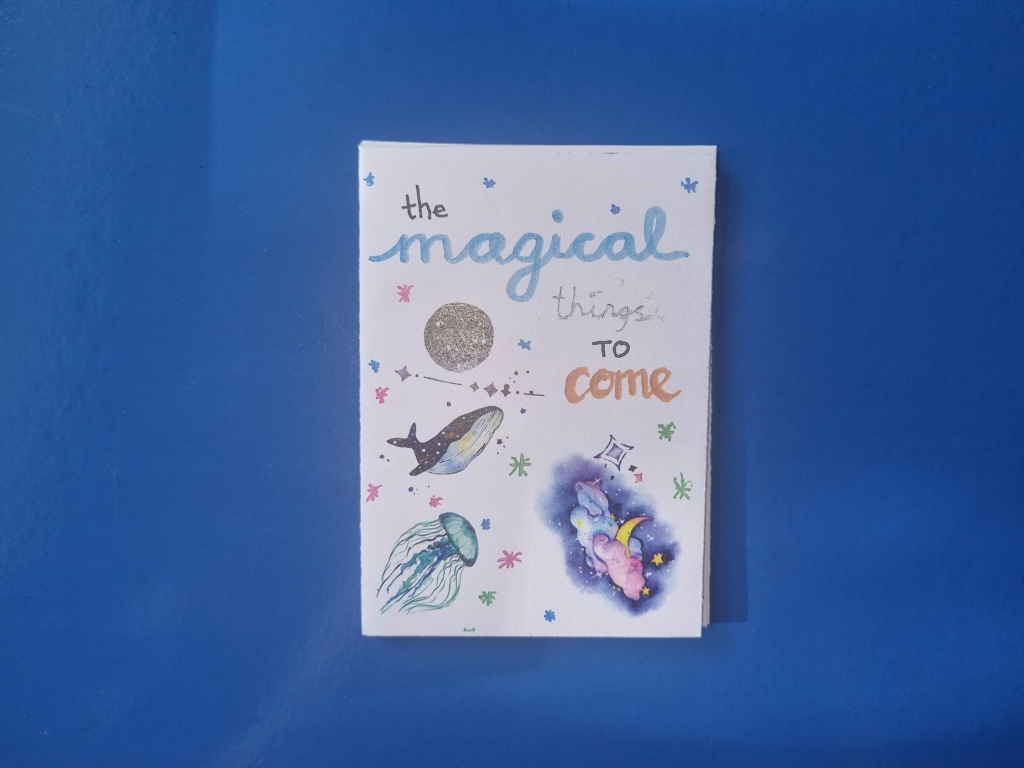
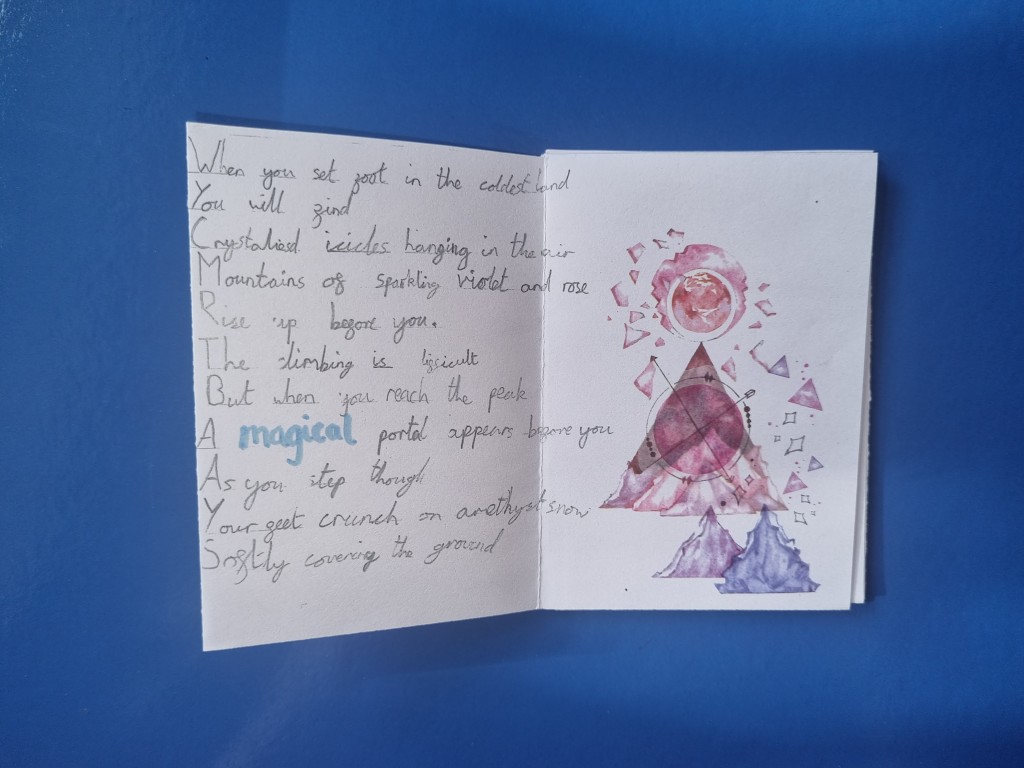
Our first submission comes from Blanka Pillár, a 16-year-old from Budapest, Hungary. She describes herself as having a ‘never-ending love’ for both creating, and for learning. Blanka in her work demonstrates a youthful passion many of us can relate to, an expression of self and surroundings.
xorex, by Blanka Pillár
in a stream of flowing tears they drifted cuddling
forgetting the round past of two other people
they floated under the cloudy sky of shouting storms
staring faceless into each other’s eternal souls
with eyes closed and tongue bitten out
they waited, lying on the calm sea of eternity
in the never-quieting din of endless battles
Sunk beneath the thick waters in each other’s silent words
In her poem xorex, she tells the story of two beings holding each other, appreciating the peace of their present in an attempt to forget the loudness of their past. The image of ‘shouting storms’ coupled with following ‘eyes closed and tongue bitten out,’ hints to the audience that the pair have been going through a rough patch in their relationship, be it romantic or platonic. From this poem, I gather that the pair struggle to communicate how they feel, that when they speak their words don’t come out as intended which leads to frequent arguing – they have learnt that sometimes it is easier to communicate through actions, such as their passionate embrace. The poem gives a sense of weightlessness, the poet uses the silence of the pair to highlight how there has been a weight lifted off of their chests which allows them to open back up to their sensitivity. I thoroughly enjoyed this poem, I think that it is highly successful in its attempt to create atmosphere. Considering her age, it’s likely that we have an up-and-coming star poet in the making.
In his poem New Year in London, poet Ali Ashhar (Twitter: @AliAshhar11) has written from the perspective of an individual walking through the streets of London in a self-reflection of how their year has been, whilst eagerly awaiting the prospect of what the new year may bring them.
New Year in London, by Ali Ashhar
Hazy winter embrace
the ambiance in London
we stroll through Westminster bridge
as the breeze of memories gush
new year gives a call
we seek to chase it down
amidst the melodramatic
December adieu
in the meanwhile,
we are held by erstwhile flashback
aftermath of grim
bygone nights
covered underneath
the seasons of sunshine
like the rollercoaster
London Eye ride
filling the fleeting time’s palette
we anticipate new dawn of life
lucent rays of faith
descending down from the
horizon of January—
a new beginning awaits.
If we look at the structure of the poem, Ashhar is compelling when using features such as punctuation (or lack of) alongside the intentional shortened line length to his advantage in manipulating the flow of the poem. It is important to acknowledge that the only full stop used is directly at the end of the poem, following the final word of the final line, which allows the poem to draw to a neat and concise ending. It also assists in pushing the image that the year which he is reflecting on is coming to an end, signifying a hopeful optimism for the upcoming year. Ashhar has one previous poetry collection published titled Mirror of Emotions (2021), within which he reflects on the journey of life. As always, a link to his work will be available in the credits section of our magazine.
When delving into the range of emotions poetry can provoke, it is often good practise for poets to use their work as an outlet for processing emotions. In the following poem, Red wine at night by Blake Everitt, we see a narrator who comes to terms with their wine drinking being related to feelings of depression, anxiety and loneliness.
Red wine at night, by Blake Everitt
It is true I write poems in the morning,
Drink red wine at night.
It is true I did not want to live
For thirteen years after my father died.
It is true I found refuge and poetry
In the downs and cliffs of this island,
When labelled redundant by those
In charge of my job.
It is true I never thought I could be loved.
It is true that we love each other: unbidden,
Unexpected, painful and amazing
It’s true, as suddenly winter sunlight flares
And starlings crowd the lawn.
Everitt lives on the Isle of Wight, a small island in the middle of the English Channel. His most recent collection that I was able to find online was Beyond the Babble (2021), and as always, the link is available down below. When speaking in an interview to the Isle of Wight County Press, Everitt describes the collection as having a heart that has ‘a profound engagement with the many sacred sites — and sights — of the Island.’ With a population of around 140,000, whilst being one of the most stunning retreats within the United Kingdom, it could also be argued as one of the most isolating. This can be seen as being reflected through Everitt’s poetry. The voice of Red wine at night has struggled past many obstacles in their journey through life, such as their suicidal thoughts after the loss of their father, and feelings of failure surrounding the loss of their job. Their isolation could have made their mental health worse, allowing for them to give in to the temptations of alcohol to mitigate the sadness – however, their isolation has also allowed them to find a serenity in nature, which has inspired them to write poetry. The ‘we’ in ‘it is true we love each other,’ could be in reference to the protagonist’s relationship with nature, as through the good and the bad, nature provides an escape – a retreat from the toils of reality, into a fortitude of tranquillity.
Nature is a common theme across poetry, with many believing it to have a variety of healing capabilities – such as stress relief and lowering blood pressure. In our next poem by British poet Neil David Mitchell, titled White Loch, we delve into the act of wild swimming, also known as cold water swimming, which Mitchell and his wife took up during one of the coronavirus lockdowns.
White Loch, by Neil David Mitchell
Skinned like a spaceman,
(Neoprene, an epidermis nexus)
Ready for this gravitational trick,
Five millimetres thick.
A shoreline launchpad,
A chattering caped community,
Ground control’s a travelling rug for mugs and towels to hug.
Barbeques, fire-pit drums primed for re-entry.
A paddle board relaxes, sighs its strong exhale.
Thermos insulates a body’s coming calefactory
Satisfaction.
Leaving earth for a spell,
An inverse evolution of sorts,
The mission touches down.
Tethered, buoyant,
Through the hopping of the brown trout,
Goes a starfish fall of faith,
Body braced, submerged,
To let cold-water seep in its
Oxygen flood.
And scan below the surface green,
Turn turtle, weightless,
Arcadian, serene.
Mitchell described how he uses poetry as an outlet for retaining memories and emotions in a written form. He said that upon deciding to take up outdoor swimming, that he bought the thickest wetsuit possible, and in turn discovered the pleasure in buoyancy – the same buoyancy that can be related to the zero-gravity felt in space, which in turn inspired this poem. Whilst outdoor cold-water swimming can sometimes be dangerous, when done safely it can have many positive attributes, such as the aforementioned stress relief. The narrators feeling of floating throughout the poem can be linked to both the physical and mental weight being lifted off their chest. The image and emotions of the poem link well to the structure, as the variety in line lengths create a visual bobbing motion. My dad loves physics, and my mum loves astronomy, so growing up in our household provided us many opportunities to fall in love with the vastness of outer space; this poem really speaks to my soul.
Shamik Banerjee is a poet, and poetry reviewer, from the Northeast of India. When he is not taking long strolls and spending time with his family, he spends his time in solitude, allowing for poetry to provide him happiness. In his poem, The Village Children’s Routine, he explores the day-to-day life and activities he has observed in one of the villages he has visited.
The Village Children’s Routine, by Shamik Banerjee
Rose and Ronnie! be awake!
The Sun is up! The Sun is up!
The Ewer fill with tea to sup,
I’ll gather lightwood from the brake,
Then ere we will aview the main.
Rose and Ronnie! Gruel cook!
Father soon will go a-tilling!
I will do the pitcher-filling,
And scrub the saucers by the brook,
And ere we will stravaig the plain.
Ronnie, make the bale of hay,
And Rose take silage to the fank,
I’ll bathe the cowlets at the stank,
All! quick! before arrives noonday,
For we will watch the passing train.
Nine it is! come! hurry on!
Rap on the door of Elliemae!
We’ll meet Tim who’s at the linhay,
Thence find the cerise Common Faun,
Towards the acme of the hill.
We will sashay, hands in hands,
‘Mid Chardonnays and Blueberries,
And beshape five little ferries,
From leaves where the Black Walnut stands,
and float it on a burbling rill.
‘Round a branch of hardwood tree,
We’ll twine a rope for tyre swing,
And we will sway, whistle and sing,
And rest beneath the Hickory,
And freshness of the breeze infill.
And watch the stag, and the doe,
And watch the farmers work on farms,
And watch the Bur Oak’s leafy arms,
To those asweat men give shadow,
And noon will occur tardily.
Puddings, apples, pot roast meat,
That we have brought, will delectate,
Then each other, our dreams relate,
Upon the culvert’s grassy seat,
While sitting there reposedly.
And soon will starshine descend,
As tweenlight will pend down from sky,
To all of them, we’ll say goodbye,
We’ll await for the night to end
To meet next morrow, happily
His use of language is unique, I enjoy the way he uses more phonetic sounding spellings (ere instead of here) to recreate how people would speak in real life within his poem. The repetitiveness of certain short words and phrases, such as the overuse of ‘and’, relates to how children often speak, in long winding sentences usually with numerous filler words such as and, um, like, and hmm. Therefore, he is successful in his attempt to recreate the children’s youthful simplicity in the way they speak to one another. Another way he does this is through his use of punctuation, sentences tend to be short and snappy, a number of them ending in an exclamation point. This indicates childlike excitement and wonder, as they cannot wait to interact with others. When read aloud his poem has an excellent sense of rhythm, giving the poem a good flow with the semi-rhyme scheme throughout the poem.
Next up we have a combination of both poetry and artwork, sent in by Helen Rebecca Hart.
White, by Helen Rebecca Hart
It’s snowing in California,
Yet it’s not here.
Blue skies – white clouds
Breeze freshened and enlivened,
no more tears.
Was that once a baby shampoo,
to avoid the pain.
When we face the pain,
strength remains.
Dark night right now,
stars above.
In Australia daytime White dove.
Yellow pansies, daffodils too.
Roses blooming you, me, too.
The purest love as we can see.
One to one….
…We can be.
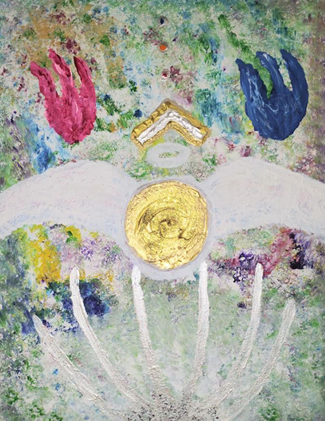
In both of Harts works we see numerous religious images displayed in a variety of ways. The poem itself relies on the narrator’s detachment from earth, as it gives hints towards them being in heaven and looking down on the world they can no longer be in. The artwork itself aids in this by its use of colours. Gold is typically the colour chosen to represent Gods and deities; gold is a luxurious material which is difficult to get hold of, therefore it makes sense that religious places of worship (including several non-Christian temples) would use gold to exhibit the intensity of their devotion to their faith. Blue could be in reference to the ‘perfect, pure blue,’ also known as biblical blue, as described in the bible it is a shade so beautifully indescribable that to this day, we still aren’t sure of which shade it must be. Blue links to the emotions of loyalty and trust felt by followers towards their faith. The red could symbolise the holy blood of Christ, alongside the sacrifice of religious martyrs; red is often used to represent passion and devotion. On the other hand, green is used to signify fertility and fruitfulness, in Christianity it’s often used to show Gods love for humanity, as seen in his beautiful creation of nature. The colours of the painting link nicely to the brightness of the earth described in the poem, allowing the audience to develop the image of the distinction between the world of the living being bright and full of life, versus the unknown of the afterlife.
When exploring the existentialism of life and death, it’s important to remember to live in the now. Each kiss, hug, or even something as simple as a high-five, greatly impacts on our emotional state and the way we interpret the world around us. If we look to examine earthly emotions, it is important to highlight that things aren’t always what they seem. This is something that can be seen in the following poem, Antique Love by Razeena Mustafa (Instagram: @its.razeena), which explores youthful first experiences with love and finding the one.
Antique Love, by Razeena Mustafa
It must’ve been fate when I heard the chime
The doorbell ringing right on time,
My eyes found you as you walked into the store
You looked so grim as you looked around in bore,
Among the cheery laughter and smiles
You were the only one who appeared hostile
I should’ve looked away, but every second grew longer
As I watched you across the room like a stalker,
My heart burned with desire to get to know you,
And as your eyes met mine, I wondered if you thought that too
Was it a split second or an eternity
I wish it would’ve lasted longer, our serendipity,
The way your eyes seemed to glow on mine
Was this a sign our lives would intertwine?
But you looked away
breaking contact and my hopes along the way,
Alas, being amongst rows and rows of books didn’t matter
Fairytales and love stories were all meant to shatter.
The narrator is enveloped in an almost childlike innocence when they lock eyes with a random stranger in a bookstore. Despite the stranger giving off a hostile aura, the narrator can’t help but be drawn to them like a magnet. Possibly because of their youth and naivety, possibly because of their passion for reading. It’s common for people who have a passion for reading (romance enthusiasts in particular) to look for similarities between literature and their own lives, as it feels as though you are a part of a larger story, within your own book. As someone who also loves to read, I can admit that I’ve fallen victim to the romanticisation of everyday life. When reading her poem, I could picture myself as the narrator, and I think many other literature enthusiasts would also be able to. Readers are often described as dreamers, we love what we read and want to be a part of it – and I think Mustafa captures this beautifully in her poem.
However, as seen above – life doesn’t always go according to plan. In our next submission PICC Line, by British poet Christian Ward (Instagram: @fighting_cancer_with_poetry), we delve into the world of medicine and terminal illness. The title of the poem is simple, it gives name to the object that is the main subject of the poem. Despite the object being inanimate, the poet gives the PICC line a life of its own.
PICC Line, by Christian Ward
Let’s pretend you have a trophy
to congratulate you surviving
chemotherapy and radiotherapy,
your hair falling out until a scalp
drier than the Kalahari remained,
talking to your shadow until it got fed up
and left, dealing with consultants
and their schtick until you brayed
like a donkey and begged for them to stop,
and every scan which showed how much
the cancer ravaged your body
like a wildfire that didn’t understand
the word mercy. Let’s imagine the trophy
is real and attached to your right bicep
like a conjoined twin from a Hammer horror,
with the two lines, long as snail tentacles,
peeking out from the cloth to prod at your failings, to ask why you hadn’t
noticed them earlier, or simply given up.
PICC lines, also known as Peripherally Inserted Central Catheters, are thin tubes designed to deliver medicine to the large veins surrounding the heart. In this poem, the author takes inspiration from his own experience with PICC lines delivering vital chemotherapy drugs. In using ‘trophy’ to describe PICC lines, it gives the object value – in a way they can become a symbol of hope for a future of remission. However, the author personifies them into ‘snail tentacles’ which remind me of snakes and serpents in the way they both physically look and behave. Ward released a poetry collection titled Intermission back in February 2023, the link will be available down below, so definitely check it out if you are into surreal poetry.
Within literature, it’s not uncommon to encounter a crossover between numerous genres and platforms, it is becoming increasingly more often to see influences of novels and music in poetry. In our next submission by Christelle Lardizabal (Instagram: @cherrimiyu) we see that her poem is influenced by both.
Prince of Plastic, by Christelle Lardizabal
through the hallways i listened
to that singsong melody
through your perfect smiles
the roses bloomed
there is no ‘melody’ in business
happiness only reserved for celebrations
through your plastic smiles
the roses wilted
i hate it, brother
your fascination with that stupid
fake
crown
The author has used their previous experience of writing prose to inspire the characters of the poem, that being two brothers in the royal court who hold titles close to the crown. Yet the narrative takes inspiration from the song ‘The Ballad of Sara Berry’ from 35MM: A Musical Exhibition (a musical compiled of snippets of stories, aiming to push ‘the limits of self-expression to create an art form utterly of its own https://ryanscottoliver.com/show/35mm/). ‘The Ballad of Sara Berry’ follows a high school student who goes on a murderous rampage to ensure she wins the title of Prom Queen and maintains her parents’ happiness. The premise of the song is that her parents have made it clear to her that the title of Prom Queen represents success in life, that coming in second and having the title of Prom Princess would instead mean she is destined for failure. Lardizabal has cleverly used structure to reflect the decline of both the relationship of the two brothers (they will grow apart as a one-sided rivalry unfolds), and the mental health of the brother obsessed with acquiring the crown (he will lose himself in a race his brother is not interested in). The sparsity of the words towards the end signifies the narrator’s hatred for the crown and the detachment he feels towards the title of King. Her use of white space and word placement is highly successful in its intent, and if she intends to publish in the future (be it prose or poetry) I would be happy to help promote.
Whilst poetry can be used to explore relationships with others, it can also be used to explore the relationship we have with ourselves. In our next submission, blood moon by Jennifer Edwards, we see a poem inspired by the menstrual cycle which explores the relationship the author has with different versions of herself at different hormonal stages of her cycle.
blood moon, by Jennifer Edwards
if only i could
preserve this sunlight
this electric, tantalising
honey-soaked sweetness
that softens my soul
and warms my worn skin
Edwards looks to capture the happiness she feels towards the final days of her cycle where she feels her energy has been restored and she has been rejuvenated. She said that she wishes the ‘positive, energetic version of me [could] stay that way forever’. Her choice of words is interesting, as most people who have periods don’t tend to look upon their menstrual cycle fondly. For many, it not only brings about pain and discomfort, but intensifies feelings such as stress and anxiety. However, the poet cleverly chooses to focus on the positive aspects such as the bliss felt towards the end of the cycle when oestrogen levels begin to increase. When the oestrogen levels increase it can also affect the amount of serotonin released by receptors within the brain – this is something the poet has captured within her poem. Words such as ‘electric’ and ‘honey-soaked sweetness’ are exciting, as it isn’t the first images that would typically come to mind when you think of menstrual cycles. It is refreshing to see the poet opt for words with such warm, soothing connotations. We often associate menstrual cycles with negativity, be that because of the pain that comes with them, or because talking about them is taboo. Edwards is completely right, and her poem thus proves certain aspects of the cycle aren’t talked about enough.
When Abby Moeller’s submission email came through, I was delighted to hear her describe how she doesn’t like to be limited in her creativity. Well Abby, you’ve definitely found the right magazine for you. We accept any and all forms of poetry, be it:
– Traditional written poetry (free verse or structured)
– Photos of sculptures or paintings
– Photography in a wider sense (this generally tends to be graffiti, signs, or something strange looking: things that make you think)
– Collages
– Videos of poetry readings
– And anything else you find yourself passionate and inspired by
We implore you, send us your unconventional work, and we will do our best to find it a home if not with us, but with another magazine or press.
But I digress, Moeller said she uses poetry to explore complex emotions, thus aiding her to recognise and evaluate how she is feeling. It also allows her to break the monotony of everyday life, which I highly relate to (especially experimental and contemporary poetry). Her submission is a duo piece of blackout poetry, both created from a single page taken from within the novel The Devil’s Necklace by Kat Martin (she did write a disclaimer that no new books were harmed in the process; this book was bought in damaged condition and is one she uses regularly for creative purposes. Go Abby!)
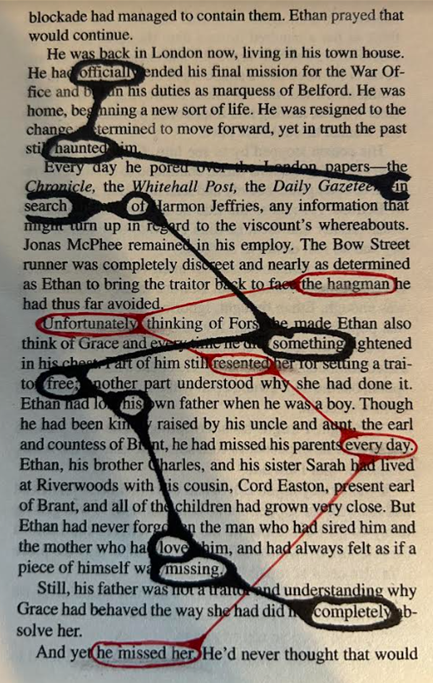
The black poem reads:
Officially haunted in search of something free; his love missing completely.
The red poem reads:
The hangman unfortunately resented everyday he missed her.
To me, this dual poem is extremely impressive. I could only dream of having the talent to be able to create something of this magnitude. Moeller can crossover the poems in allowing them to have similar themes, whilst they are still separate from each other; the two poems speak in conversation to one another and work perfectly. The longer I look over the poem, the more excited I am that hopefully we will see more of Moeller’s work in the future.
Ness Healy (Twitter: @NessHealy) is a Scottish based poet who studies English Literature and Creative Writing. She is previously unpublished, but from her submissions email I would love to see further work from her if she decides to publish in the future. In her poem butterflies/moths, Healy looks at using animals, specifically butterflies and moths, to represent the relationship of two lovers in a secret relationship who dream of running away together.
butterflies/moths, by Ness Healy
the street is silenced by dusky snow
i lean against her rosy glow
my cheek on her cheek, a downy peach
i flutter my lashes beside her nose
a butterfly kiss; no one can know
we kiss when no one is around
relentless, until almost drowned
her delicate breath, the warmth of her flesh
safer than the softest eiderdown
her dovelike coos are a sacred sound
together we lie, her bed a cocoon
our promised wings emerging soon
her languid lips, hot hands on hips
our limbs entangled, our secret room
a pair of moths, drawn to the moon
The poet uses words to her advantage, choosing soft, warm words that aid in creating the image of delicate butterflies. The delicacy of the butterfly could possibly be in reference to the delicacy of their relationship, as they are a secret, the pair may be walking on eggshells to keep themselves hidden. I love the image of ‘my cheek on her cheek’, as to me it allows me to envision the wings of a butterfly flapping its wings, focusing on the moment the two wings touch when they are at their peak. The structure also assists in this image from the three individual lines that fall in between stanzas, acting as a volta to shift from one image to another. The image on the final line is highly successful (and beautiful) in its attempt to portray two moths dancing around one another, chasing each other under the moonlight.
The next submission takes on the form of a letter, from a single bacteria cell to its mother. Monster was first published by Iceblink Lit, Ashwini Gangal (Instagram: @readerashwini, Twitter: @writerashwini) uses the bacteria as an interesting perspective change in viewing human relationships. Gangal uses poetry as an expression of lived experience, seen in how the poem takes inspiration from when the poet was sick with the flu, which she caught from her husband. Gangal describes herself as ‘a psychologist by training, journalist by profession, fiction writer at heart, and has the soul of a poet’. During the 2020 coronavirus pandemic she became an avid reader of medical anthropology and plague-themed literature, developing an interest in the way microbes and bacteria shape human lives.
Monster, by Ashwini Gangal
Dear Mamma,
Who is this beautiful monster with
four lungs and two throats?
At daybreak its body splits in two, and
each half walks around separately
At moonrise the halves connect,
first at the fingers, then at the mouths
As the monster’s four legs start to entangle, I can’t say
where one half ends and the other begins
As they fuse, they rub and writhe, shudder and sweat, until
finally whole again, it sleeps in the dark, breathing
through four nostrils
Like you taught us, I incubate my kin in the hairy half of the monster for a few days, till he purges us with syrups and steam,
but not before some of us are ferried on seas of sputum to its other, smoother half,
where we can continue our carnival,
making her sneeze, cough, spew and sniffle
Sincerely,
Baby Bacterium, 2023
Being of a different species, the bacteria doesn’t understand and is unable to comprehend the relationship between two humans (as bacteria use binary fission, or asexual reproduction). To the bacteria cell, the two humans merge to become ‘one large, mysterious mammal with disproportionate, detachable parts who pass on the flu to one another when they get intimate’. It is interesting the way that Gangal breaks down the human body into physical pieces and uses it to construct a monstrous figure. Whilst we see bacteria and germs as a concern for human survival, the planet sees humans as their version of bacteria. This poem really made me think about the way it could be argued that humans are the real monsters for the way that we have spread to every crevice of the planet; with plastic being found in the Marianas Trench, almost 11,000 meters below the surface of the ocean – an area where it is uninhabitable for humans due to pressure, is being damaged from so far away.
Our next poet has a slightly more unusual background; Neal Mason is 74 years old, he was born in Middlesex and raised in Norfolk. His first poetry collection, Excavations, was published in 1991 by Peterloo Poets, with his second poetry collection Leading the Guidebook Astray was published in 1995 by the University of Salzburg Press. He then went on to be a Writer in Residence for the Arts Council, in Welsh Valley, tutored courses for the University of Wales, was chosen for a poetry masterclass in Hay-on-Wye, and even advised the Art’s Council Grants to Publishers Panel. He is clearly an experienced poet, who has spent the last five years running a non-profit poetry website (https://www.soundwork-uk.co.uk/) that provides recordings of books, plays, and poems free for listeners. His most recent poetry collection, The Past is a Dangerous Driver, explores the different ways history can be interpreted, the link to his work will be available below.
The Rock, by Neal Mason
Headland behind him, he pointed
out to sea, lighthouse balanced on his hand,
unsheltered village nestling his neck, as though he,
motionless, sustained the Norfolk coast
as well as sustaining me.
Although he merely referred
to a distant boat, the image of instant dismissal
crossed my mind, bobbed and began to float
before my eyes, and I was at sea,
ever more remote.
Yet he has sustained a landscape,
in a way, for I’ll never see him move
again, memorialised for ever on that day,
though lighthouse and village crumble and fall
from his arms and are washed away.
Mason’s work is clearly influenced by his lived experience, as we can see he refers to his hometown of Norfolk, where the famous Happisburgh lighthouse resides. Happisburgh lighthouse is one of the oldest remaining lighthouses within the UK, whilst being the only one that is independently run. Mason personifies the coast into being a ‘he’, with the coastline having a long outstretching arm that the lighthouse sits upon at the end of, on his ‘hand’. Sadly, the Norfolk coast is one which is deadly for coastal erosion. Whilst it may not happen in the narrator’s lifetime, the poet highlights the threat of erosion by acknowledging that the lighthouse and village nearby will one day ‘crumble’ and fall into the ocean, where it will be washed away. The image of the beautiful lighthouse, standing in all its glory, is memorialised in art, such as photography and literature (novels and poetry).
Our next poet is also a highly published author, Stephen Allen is a retired doctor and physician, who lives in Salisbury with his wife. During his career as a physician, he has been published over 200 times in a variety of research papers and textbooks. However, he has had a lifelong passion for reading and writing poetry, particularly delving into the exploration of the links between humans, the natural world and recurring myths. He has been published in poetry magazines, but his most recent poetry collection Unfrozen (2022) will be available down below.
King of the moor, by Stephen Allen
Wren stands on a weathered tor
Small, quick and unafraid
A worry for the knowing Celts
Flitting from the wran-boy raid
To revel in its pert contempt
For lesser birds and roaring men
With a burst of unmatched sound
The bird-king sings the laws
Heard by every rook and jay
And all with wings and claws
So, woe betide the feathered nests
Of subjects with subversive thoughts
The eagle and the condor bow
Before this tiny archosaur
Trapped inside a custom-well
Re-proclaimed across the moor
Its given right to rule the air
They never think to challenge
It is a trick of confidence
That keeps the Wren in power
Seen, then not seen, within a trice
Then proclaiming from a tower
In a voice that can’t be questioned
Emitted from a legend-throne
Hobnob Press, the publishers of his collection Unfrozen, describe his work as being a reflection of his ‘interest in the natural world [and] wildlife conservation’. This is evident in his poetry, as we can see his focus on the Wren as a powerful feature of the ecosystem shows that he believes every animal, even those of a minute size, are vital to the environment’s survival. No other animal has quite the grace and confidence to pull off the success of the Wrens movements, despite them being a common bird the poet highlights their magnificence. The poem is written beautifully, it allows for me as a reader to envision my local wildlife preservation, and wish it wasn’t raining.
Treziel Mae Mayores is a 21-year-old young writer from the Philippines. She describes herself as ‘loving the rainy season but treats the sun as her muse’. She loves to go biking, and also cuddling with her cat, but when she isn’t doing either of those things, she can be found writing on her blog Ramblification (https://ramblification-rambles.blogspot.com/). She has been writing since she was in the 4th grade, because she discovered she loved looking back on her past writing like a time machine acting as a portal to the past. Her poem, Doors, was written during one of the coronavirus lockdowns, therefore I can deeply understand the narrator’s feelings of stagnation.
Doors, by Treziel Mae Mayores
life is like a series of doors,
you open one after another.
sometimes one can be easy to open
as a puff of breath, the door would creak release.
sometimes it can be hard to push ajar,
heavy metal, crooked knobs and rusty hinges.
It’s a draining–back-breaking task
but you can’t go back,
you’ll see series of opened doors behind
that you fought hard to get past.
you’ll realize, though they were hard to crack,
none of these doors were locked.
From her poem, we see life as a progression of stages from one room to another through a series of doors we are unable to open. During the coronavirus pandemic, it was difficult for many to adapt to being at home and everything moving online (work, education, shopping, socialising, etc.). Progression in the workplace became harder with online work via Microsoft Teams and Zoom. Less face-to-face time meant employers could expect employees to work unreasonable workloads in unrealistic timeframes, yet expect the same results as though they were working in person, without having to feel the guilt of the pressure they put on them – because they didn’t have to see their faces. The cost of living has risen, and so has inflation, yet companies are unable to compensate those who work hardest to keep them afloat, keeping the bonuses for the upper management only. The everyday person keeps hitting different hurdles in life, significantly more than their predecessors. Mayores’ poem perfectly encapsulates the difficulties that life has been throwing at us, the doors to progression may not be locked, but the weight and pressure we feel to stay afloat both financially and mentally is draining, leaving many of us to wonder how we will recover.
For our next piece, we see a group submission by SOUM (Screams of Unfettered Minds). They are a group of three girls from New Zealand who cherish their anonymity, preferring to let their work speak for them. They decided in 2021 to finally start putting their thoughts to work in creating (both literature and visual artwork) SOUM. Their website (www.unfetterednfts.com) describes their work as coming ‘from deep wells of memories, insecurities, observations, the deepest pain and the highest joys. We’ve climbed mountains and tumbled right back down again. But always, we get up and start climbing again.’ What their group is attempting (and achieving) certainly places them within the experimental and contemporary genre. Check their website out, as I found it really refreshing to see a project being worked upon by poets as a collective group.
The Abyss, by SOUM
I’m sick of this torture I do to myself
It built ‘cos I didn’t reach out for help
Oppressed and neglected and now compelled
To free every shadow that inside me dwells
Caught in a crossfire I can’t defend
Self-condemnation beneath my breast
Life can be cruel, no room to pretend
Can’t ignore issues so long suppressed
The road to recovery is paved with nails
That impale my soles as I walk the trail
Afraid to move forward, afraid to fail
Examining every minute detail
Exhausting is this bloody shadow work
The blurring of mind and reality hurts
Confronting the cause of the pain is worse
Cowardice rises to harm and subvert
It’s not all that simple to live or die
I envy those people that never deep dive
I want to live, but I’m not alive
An endless struggle to stand and rise
The Abyss describes a narrator who longs to be freed from the cage of past mistakes. Sometimes our brain can fixate on the mistakes we make (even the small minute ones), which in turn creates a torturous environment where we dwell on the negativity, letting it overwhelm and encompass our lives. The narrator feels as though they are drowning in their own mind, unable to escape, despite them yearning for the road to recovery. Their involuntary obsession with their past has become exhausting, leaving them in a deep depression yet not suicidal per say, but stuck in a state of not living and not dying where life is helplessly unenjoyable.
Sarah Steinbacher (Twitter: @SarahSteinbac11) is an LGBTQIA+, disabled American poet, living in South Carolina with her spouse, three children, three cats, and one tortoise. She has an Ed.D. in education and is a member of the Society of Children’s Book Writers and Illustrators (SCBWI). Many of her previous writings have been educational and academic based, however she is branching out into creativity through her poetry. She has recently been published by The Dirigible Balloon, a poetry publication who aim to create a space for poets whose work is accessible for children of all ages, to introduce them into poetry without having them encounter some of the more adult topics. In her poem, One Fat Cat: A Palindrome, we see our first and an excellent example of a poem which is also a palindrome (a poem that can be read both backwards and forwards).
One Fat Cat: A Palindrome, by Sarah Steinbacher
I’m one fat cat
I accept and affirm that
My size begets ridicule, a tit for tat
I must combat the notion that
I’m someone worth looking at
My value falls flat
I’m in no position to assert that
I ought to have yummy foods on my placemat
I should limit myself to rations that are nonfat
You’ll never hear me saying on snapchat
I’m the one deserving of a copycat
Instead I’m a pig in its natural habitat
How does one arrive at the idea that
I am more than just a doormat
After all this chitchat, will you finally see that
I’m all that
Steinbacher described in her submission email that she is a supporter of the body neutrality movement, a movement that aims for people to exist within their body without judgement for their appearance, but for who they are on the inside and their actions. In her poem, we see a reverse in opinions. If you read it downwards, we see a narrator who belittles themselves due to their size, most likely due to societal pressures to conform to their image of beauty. Whereas if you read it upward you see a narrator who defies society’s belief that you must be skinny to be happy. They are happy as they are, and that is what matters. I myself have never written a palindrome, but I know they take an exceptional mind to create one. The time and effort put into this poem, has really paid off. I hope to see more of Steinbacher’s work pop up in the children’s poetry field soon.
Thank you for reading the third edition of Tap into Poetry, this one has been a long one (over 7000 words!) but it was worth every minute of writing, as we have explored so many excellent pieces of poetry. I’m so happy to see how many people have not only submitted to edition three, but are also ready for edition four (to be released in June 2023). As always, we hope to see you again for the next edition, make sure to subscribe so you don’t miss out!
Credits
Allen, S. (2023) ‘King of the moor’. His most recent collection: Unfrozen, Hobnob Press: https://www.hobnobpress.co.uk/books/p/unfrozen-poems-of-the-west-country-by-stephen-allen-1
Ashhar, A. (2023) ‘New Year in London’ Twitter: @AliAshhar11 Amazon: https://www.amazon.co.uk/Mirror-Emotions-Ali-Ashhar/dp/1639403531
Banerjee, S. (2023) ‘The Village Children’s Routine’
Edwards, J. (2023) ‘blood moon’ Instagram: @jenniferdoesbooks
Everitt, B. (2023) ‘Red wine at night’ Amazon: https://www.amazon.co.uk/gp/product/B099BZ7BFH/ref=dbs_a_def_rwt_hsch_vapi_taft_p1_i0
Gangal, A. (2023) ‘Monster’ First published in Iceblink Lit (Instagram: @readerashwini, Twitter: @writerashwini, for more of Ashwini’s published fiction and poetry visit her website: ashwinigangal.com)
Hart, H. R. (2023) ‘White’, and accompanying artwork.
Healy, N. (2023) ‘butterflies/moths’ Twitter: @NessHealy
Lardizabal, C. (2023) ‘Prince of Plastic’ Instagram: @cherrimiyu
Mason, N. (2023) ‘The Rock’. Holland Park Press: https://hollandparkpress.co.uk/books/the-past-is-a-dangerous-driver/
Mayores, T. M. (2023) ‘Doors’ https://ramblification-rambles.blogspot.com/
Mitchell, N. D. (2023) ‘White Loch’ Instagram: @neildavidmitchellwriting Amazon: https://www.amazon.co.uk/gp/product/B086X875RZ/ref=dbs_a_def_rwt_hsch_vapi_taft_p1_i1
Moeller, A. (2023) ‘Executioner’s Love’ Twitter: @abbym823
Mustafa, R. (2023) ‘Antique Love’ Instagram: @its.razeena
SOUM. (2023) ‘The Abyss’ www.unfetterednfts.com
Steinbacher,S. (2023) ‘One Fat Cat: A Palindrome’ Twitter: @SarahSteinbac11 https://sarahsteinbacherwrites.blogspot.com/
Pillár, B. (2023) ‘xorex’
Ward, C. (2023) ‘PICC Line’ Instagram: @fighting_cancer_with_poetry Amazon: https://www.amazon.co.uk/Intermission-Christian-Ward/dp/B0BVDLW1C6/ref=tmm_pap_swatch_0?_encoding=UTF8&qid=1682719361&sr=1-1
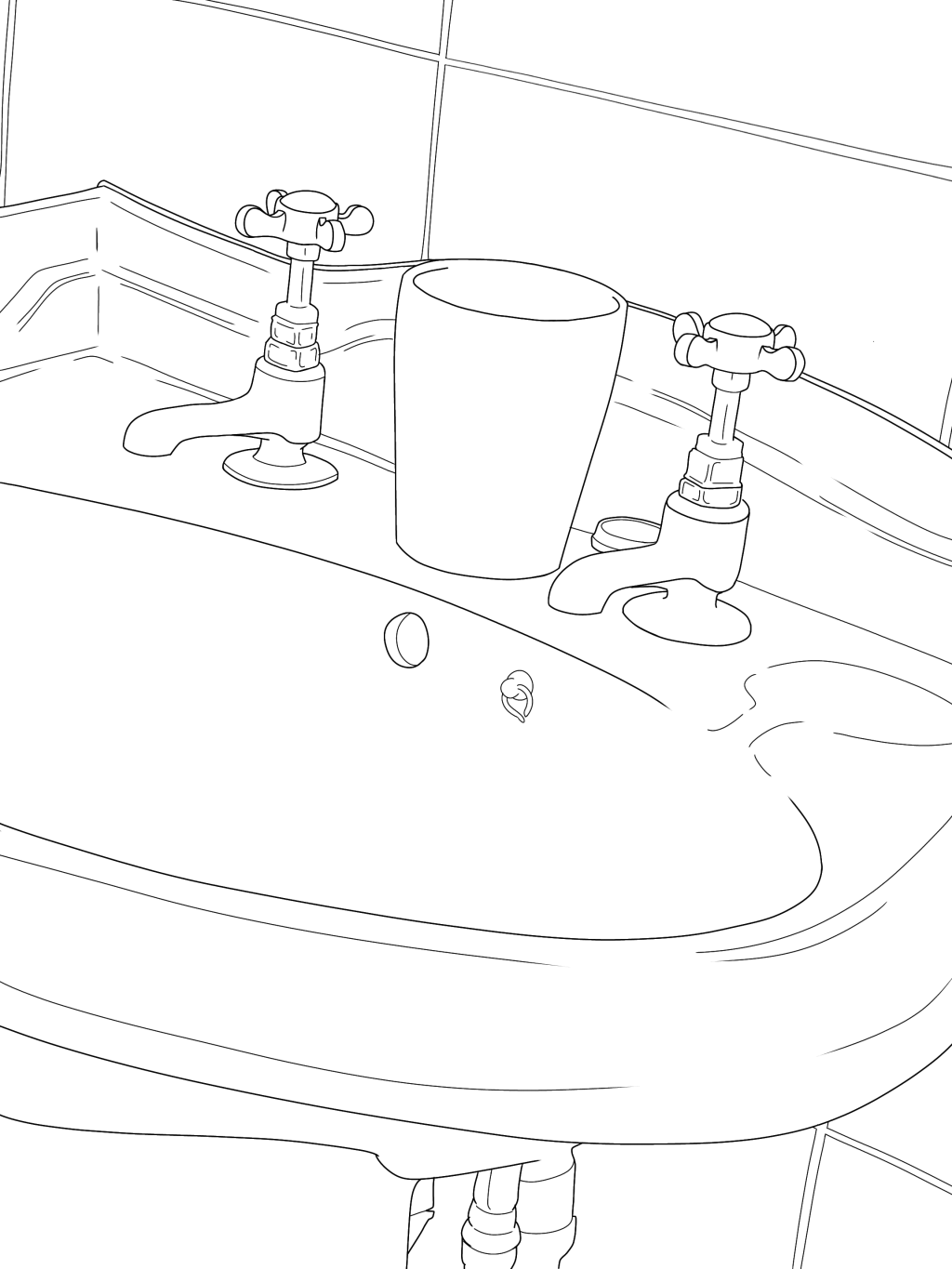
One response to “Tap into Poetry #3”
A fine range of themes and styles.
LikeLiked by 1 person